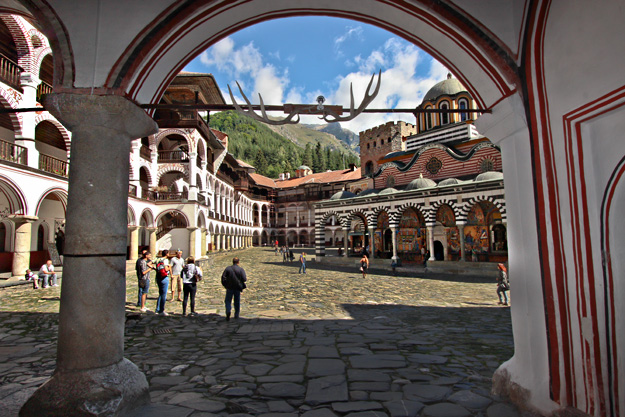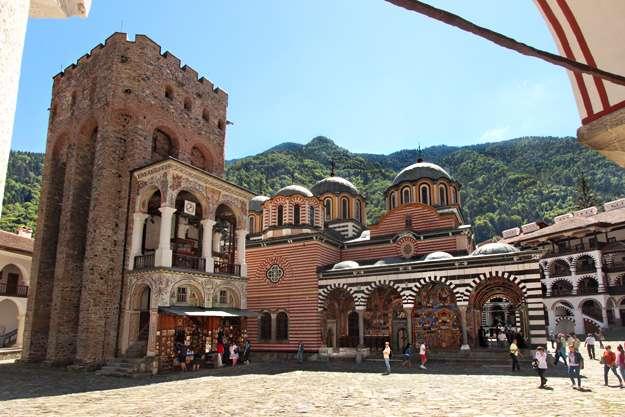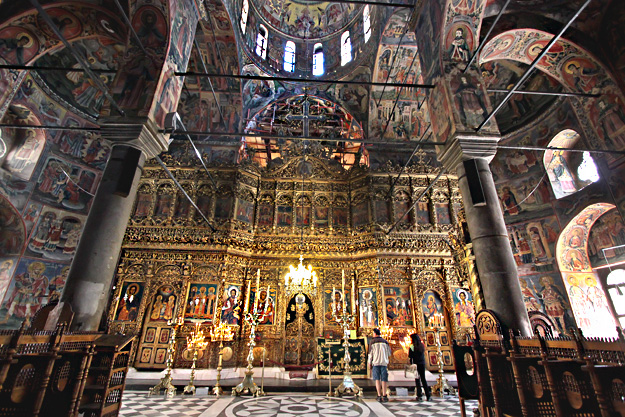During my visit to Sofia I heard repeatedly that the nearby UNESCO World Heritage Site of Rila Monastery was a must see. Based upon this endorsement my expectations were high, but my first view of the monastery’s tall stone walls left me uninspired; it appeared to be nothing more than a simple stone fortress tucked into a pretty mountain glade. Disappointed, I walked through a long tunnel to a vaulted entrance and stopped in my tracks, stunned by the unexpected beauty of the interior courtyard that spread before me.

Three stories of arches stacked on stone columns decorated the facade of monastic apartments that formed the roughly pentagonal enclosure. In the center of the yard stood the Nativity of the Virgin Church, where exquisite frescoes in the cloistered entrance peeked through black and white arches, above which red and white striped brick walls supported five burnished gold and olive cupolas topped by filigree crosses. The crenelated stone Hrelyu Tower, constructed in 1334-1335 and the oldest building at the site, rose majestically behind the church.

Ironically, this stunning monastery evolved as a result of the ascetic Ivan of Rilski (Saint John of Mila), a simple shepherd born in 876, who became a monk and retired to a cave near the present day site, intending to lead a isolated life devoted to prayer, meditation, and fasting. His plans were foiled, however, when word of his ability to perform miracles became public knowledge. Pilgrims began arriving, seeking to be blessed or cured of their infirmities. Buildings sprung up near the hermit’s cave, forming the nucleus of a community that eventually evolved into an Eastern Orthodox monastery.

The original buildings were completely destroyed by fire in the 13th century, but in 1355 a powerful local prince, Stefan Hrelyu, ordered the construction of the tower that now bears his name and is the oldest structure on the site. By the time the relics of Saint Ivan were installed at the monastery in 1469, it had become a symbol of national pride and a repository for Bulgarian literature and art, a passion that was heightened during the Ottoman Turkish domination of Bulgaria and the Soviet years.

With the exception of Hrelyu Tower and a small chapel that stands next to it, the current buildings date back to the mid-19th century, as the complex was destroyed by fire once again in 1833. Perhaps the most important of these latter-day buildings is the Church of the Nativity of the Virgin, the walls and ceilings of which are covered with vibrant frescoes painted by the top Bulgarian artists of the day.

Even more famous than the frescoes is the iconostasis, a partition separating the sanctuary from the main part of the church, which took a group of woodcarvers three years to complete. The gold-plated iconostasis gleams softly, reflecting light from a crystal chandelier that hangs from the center of the dimly lit nave, as worshipers stream in and out, reverently kissing the icons of saints embedded in the screen.

I couldn’t help wonder what Ivan the hermit, who sought only to live a life of seclusion and prayer, would have thought about the complex, which ironically attracts an estimated 900,000 visitors each year.
How to visit Rila Monastery:
Located about 73 miles south of Sofia, the capital of Bulgaria, the site is easily accessible via well-maintained roads. A day tour is also offered by Rila Monastery Bus, which combines visit to Rila with a stop at Boyana Church in Sofia, another UNESCO World Heritage Site. However, these day trips allow an hour to 1.5 hours at the monastery, which is barely sufficient to see the main site, much less allow time hike to St. Ivan’s original cave or visit his crypt and the on-site museum. For those who wish to stay longer, take a 25-minute ride on the N5 tram from behind the Palace of Justice in Sofia to the west bus station (Ovcha Kupel). At the west bus station, take the bus to Rila Monastery, which leaves once per day at 10:20 a.m. arriving around 1:00 p.m. The return bus to Sofia departs at 3:00 p.m. and arrives back in the city around 5:30 p.m.. The round-trip ticket costs 22 BGN ($15-16 USD) and is purchased on board from the driver. It is also possible to stay overnight and catch the public bus back the next day, as inns are located within easy walking distance and it is also possible to sleep in the monastery for about $20 per night.

Wow … I never thought a Christian religious site could ever be as interesting as a Buddhist or Hindu temple … goes to show that the world has surprises waiting for those eager enough to explore it!
I thought exactly the same thing, Caroline! Rila Monastery was unexpectedly breathtaking.
Hi, Barbara!
I have just discovered this amazing site and I absolutely love it! I am from Sofia and after traveliing throughout Africa and Europe, I finally returned to Sofia where I currently live. I have always loved Sofia and Bulgaria and all the amazing places we have. I am particularly fond of the Rila Monastery and other Monasteries in the country. I believe we have a beautiful nature, mountains, sea, a romantic countryside and some truly magical places. I enjoyed your story and will now go on browsing through the other places I hope to visit some day like Bali…. Good luck in your future travels! It’s an amazing experience to travel the world- enjoy! And thank you for sharing your stories.
Hi Vania: Thanks for your comment. I’m very pleased you liked my story and that you’re exploring more of my blog. I can hardly wait to go back and see more of your wonderful country.
I’ve heard of and read about the Rila Monastery before and your article and photos only entice me to visit more. Since I am often in Ukraine, Bulgaria is not that far away. We’ll have to make it a destination.
You’ll love it Greg. The monastery is absolutely stunning. Ukraine is high on my list as a future destination. What takes you there so often?
Before Ukraine was formed as a country it was part of the Great Bulgarian empire. We share very similar culture and even they use Bulgarian invented Cyrillic alphabet.
I thought Riga Monastery to be a beautiful sight as well Barbara. I would add for people who plan on going to eat at the restaurant beside the monastery and order their trout. It’s fresh from the stream you have to walk over. Delicious!
Argh! Jet lag! That’s Rila not Riga!
LOL Corinne – I never have been able to type so I have a hard time getting things right without jet lag 🙂 Thanks so much for the tip abut the restaurant beside the monastery. If I were to do it again, I’d stay overnight there.
Oh my goodness, the art and the arches are beautiful right along with the landscape to help it even more. Thanks for sharing! Will have to visit!
beautiful!
Thanks Hogga – it was a gorgeous place.
I will have to visit this monastery when we visit Bulgaria. Thanks for the suggestion to stay at the budget inn as it makes sense to spend the night rather than rushing a visit there.
George
Wesaidgotravel
You’re welcome George – glad you enjoyed my story.
What magnificent building. Shudder at what we are building today. Are those people actually swimming on Dec. 27th? Wow!
LOL Trixie – my blog articles run about 12-14 weeks behind my actual location.
Beautiful monastary – I can see that you’d certainly need more than an hour or two here to do it justice
Hi, Barbara!
Great to see an article about this monastery. I haven’t visited it since 2008 and I really miss it! I have been thinking the same thing as you – how St. Ivan would have perceived nowadays’ boom of tourists, with many of them having this place in their mind as a mere tourist destination, even though they are of the same Orthodox Christian faith. It’s an irony, really. 🙂 And yet I suppose it’s just the different eras. People back then informed themselves about life and the world around them from priests, sought help from monks like St. Ivan..there weren’t nowadays’ distractions like TV, internet.. I rather think that by evaluating the contemporary factors, St. Ivan would have been quite satisfied to know the place where he decided to find a recluse in is loved so much and visited by us, Bulgarians, as well as many people from abroad, despite all distractions of modern life. If this is the modern way to keep the faith, why not..? 🙂
I suspect you’re right Tsvetana – all that matters is that we ceelbrate our faith, however we discover it 🙂